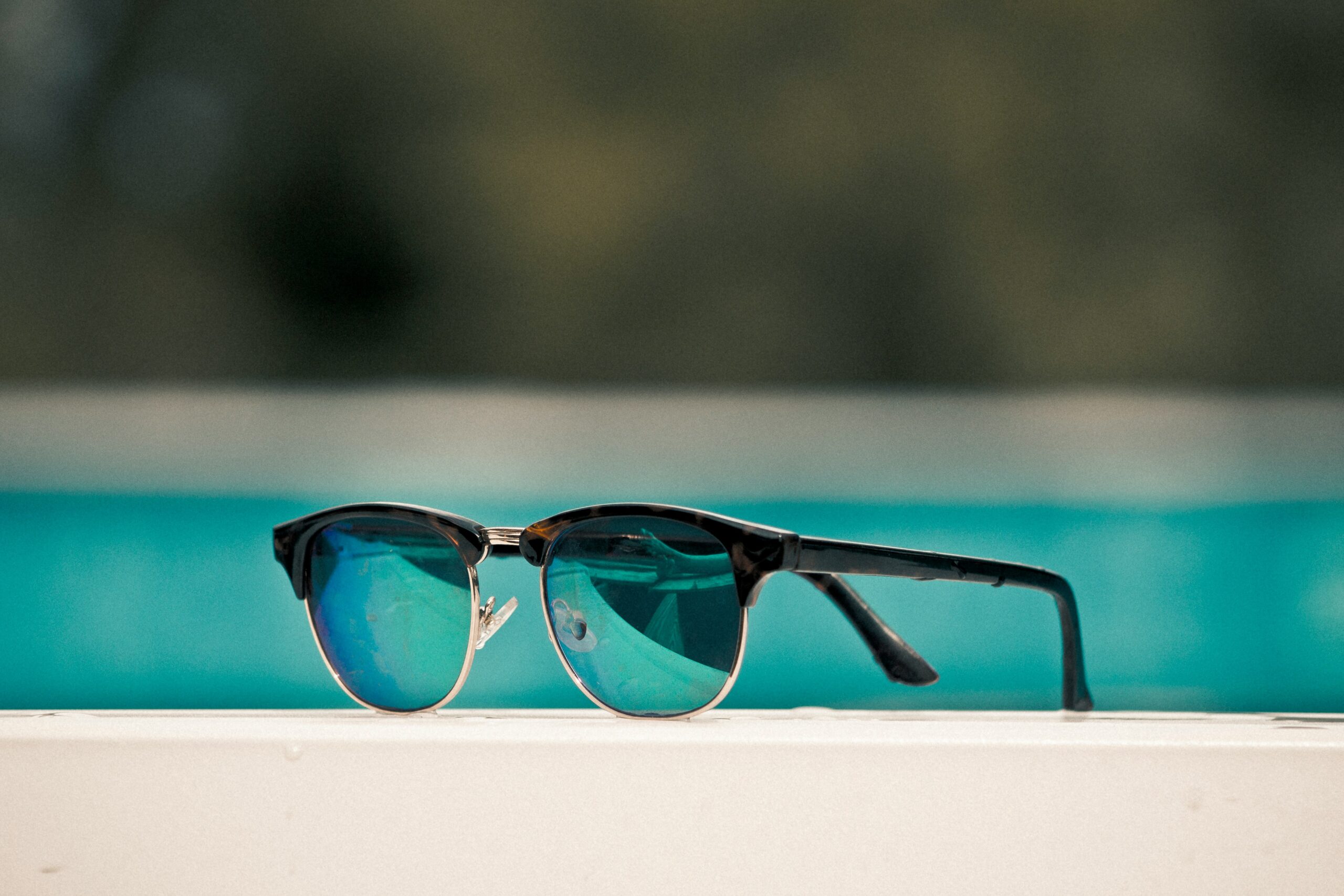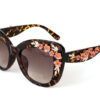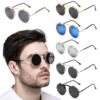
Sep 22, 2024 | Eyewear
Understanding Polarized Lenses
Polarized sunglasses incorporate a unique lens technology designed to enhance visual clarity and comfort. The fundamental difference between polarized lenses and regular sunglass lenses lies in their ability to filter out specific types of light. Regular sunglasses primarily reduce the overall brightness of light entering the eyes, offering minor relief from glare, but do not address its source. In contrast, polarized sunglasses contain a special chemical coating that aligns light waves vertically, significantly diminishing the intensity of horizontal glare.
To understand how polarized lenses work, it is essential to grasp the basics of light waves. Light travels in waves, and these waves can oscillate in various directions. When sunlight reflects off surfaces such as water, roads, or snow, it primarily reflects horizontally, resulting in pronounced glare. Polarized lenses are engineered to block this horizontally polarized light while allowing vertical light waves to pass through. This selective filtering reduces glare, enhancing visibility and reducing strain on the eyes, particularly in bright conditions.
Several types of polarized lenses are available on the market, each designed for specific activities or environments. For example, some polarized lenses are tailored for water sports, featuring coatings that repel water and resist scratches. Others are optimally designed for driving, enhancing contrast and reducing glare from wet roads. Various tints and lens materials are also available to cater to different lighting conditions, ensuring that users can find the ideal pair suited to their needs. The growing popularity of polarized sunglasses reflects their significant advantages in improving vision clarity, particularly in situations where glare is prevalent.
The Importance of UV Protection
The protection of our eyes from ultraviolet (UV) rays is a paramount concern for maintaining long-term vision health. Prolonged exposure to UV radiation can lead to serious eye conditions, including cataracts, macular degeneration, and even skin cancer around the eyelids. Polarized sunglasses are specifically engineered to provide this essential UVA and UVB protection, making them a vital accessory for anyone who spends time outdoors.
UV rays are often invisible to the naked eye, and their impact can be cumulative over time. This means that even brief exposure can gradually damage the eyes, culminating in significant health issues. By wearing polarized sunglasses, individuals can significantly reduce their risk of developing these eye problems. The technology behind polarized lenses not only minimizes glare from reflective surfaces, such as water and roads, but also filters out harmful solar radiation. This dual action enhances both visual comfort and eye safety.
Moreover, the role of polarized sunglasses extends beyond mere aesthetics or fashion statements; they serve as a practical investment in one’s eye care regime. The lenses are designed to block harmful rays effectively, which can help maintain the integrity of the retina and lens over the years. Additionally, with features such as anti-reflective coatings, these sunglasses further enhance clarity and reduce eye strain in bright conditions, facilitating better vision during activities like driving, fishing, or outdoor sports.
In conclusion, the importance of UV protection provided by polarized sunglasses cannot be overstated. Incorporating these protective eyewear options into everyday routines is a proactive step towards preserving eyesight and ensuring a healthier future for your vision.
Benefits of Reducing Glare
Glare is a significant impediment to clear vision, particularly in bright environments where sunlight reflects off surfaces such as water, roads, or snow. Polarized sunglasses have become a preferred choice for many due to their ability to dramatically reduce this disruptive glare. These specialized lenses contain a filter that blocks certain light waves while allowing others to pass through, effectively enhancing the wearer’s visual comfort and safety.
In scenarios like driving, reduced glare can be critical. Sunlight reflecting off the windshield or road can impair visibility, leading to potential hazards. Many individuals who have opted for polarized sunglasses while driving report a marked improvement in clarity, enabling them to detect obstacles, road signs, and vehicles more easily. A cyclist who switched to polarized lenses noted, “I could see the potholes much better, which allowed me to navigate more safely, especially on sunny days.” This improved visibility can contribute to safer driving experiences and enhanced confidence behind the wheel.
Moreover, outdoor enthusiasts, such as fishermen, benefit immensely from polarized sunglasses. Glare on the water can obscure fish, making it challenging to catch them. A fisherman shared that since using polarized lenses, he has not only caught more fish but also enjoyed the experience more, as he could see underwater structures and fish more clearly. The reduction in glare alleviates eye strain, allowing for prolonged periods of visibility without discomfort.
Engaging in outdoor sports, like skiing or snowboarding, also presents glare challenges. Polarized sunglasses offer significant advantages by enhancing visual clarity on icy slopes, allowing athletes to maintain their stability and awareness. Overall, polarized sunglasses serve as a crucial accessory, offering substantial benefits related to glare reduction, ensuring improved vision and safety in various activities.
Choosing the Right Polarized Sunglasses
Selecting the appropriate polarized sunglasses can significantly enhance your vision while providing protection against harmful UV rays. Understanding various features and options available in the market is crucial for finding a pair that meets your individual requirements and preferences.
One of the primary factors to consider is lens color. Different shades of polarized lenses not only impact style but also influence how much light is filtered. Grey lenses are often recommended for bright sunlight as they reduce glare while maintaining true color perception. Brown and amber lenses enhance contrast and depth perception, making them ideal for activities such as fishing or skiing, where clarity is essential. Meanwhile, yellow lenses can be beneficial in low light conditions, enhancing visibility.
Frame style is another important consideration. The design of the frames can affect both comfort and fit. Look for frames that are lightweight and adjustable to ensure a snug fit to the face, as this can prevent the sunglasses from slipping during physical activities. Full-rimmed frames offer durability and are suitable for everyday use, while semi-rimless or frameless options provide a sleek look and are often favored by athletes.
Additionally, evaluating the quality of polarized sunglasses is vital. Ensure that they provide 100% UV protection and are made from high-quality materials that resist scratches and impacts. When selecting sunglasses, check for labels indicating that the lenses have been tested for polarization. A reliable pair should blur reflections from surfaces such as water or roads, indicating effective glare reduction.
Furthermore, trying on polarized sunglasses whenever possible can help gauge the comfort level and fit. Preference for wider temples or wrap-around styles varies between individuals, thereby influencing overall satisfaction with the eyewear. A well-chosen pair of polarized sunglasses not only enhances vision but also becomes an essential accessory for protecting your eye health. By considering these key factors, you can make an informed decision that aligns with your lifestyle and personal taste.

Sep 22, 2024 | Lifestyle
Understanding Polarized Sunglasses
Polarized sunglasses are designed to enhance visual comfort and provide protection against harmful rays, primarily by reducing glare from reflective surfaces. The science behind polarized lenses lies in their ability to filter light, specifically horizontally polarized light that causes glare. When sunlight hits a flat surface such as water, snow, or a road, it creates a blinding reflection that can obstruct vision. Polarized sunglasses contain a special chemical coating that helps block this glare, allowing for clearer and more comfortable vision.
One of the most notable benefits of using polarized sunglasses is their ability to improve contrast and color perception, especially in bright environments. This is particularly beneficial for outdoor activities such as fishing, skiing, and driving, where glare reduction can significantly enhance safety and performance. For instance, fishermen often rely on polarized lenses to see beneath the water’s surface, making it easier to spot fish and underwater structures.
There are various types of polarization available in the market, or varying levels of effectiveness. Some sunglasses are equipped with standard polarization, while others offer advanced technologies that provide even greater glare reduction. Additionally, polarized lenses come in different tints and shades, allowing users to select options that best suit their personal preferences and specific outdoor activities. Regardless of their design or style, polarized sunglasses share the common goal of ensuring visual comfort and protection against harmful ultraviolet (UV) rays.
In conclusion, understanding the functions and benefits of polarized sunglasses enables individuals to make informed choices for eye protection. Whether engaging in leisure activities or daily commutes, investing in quality polarized sunglasses is key to enhancing visual experiences and safeguarding eye health.
Choosing the Right Pair
When it comes to selecting the ideal polarized sunglasses, several factors must be considered to ensure that the chosen pair aligns with individual needs and lifestyle. One of the most critical criteria is UV protection. Opt for sunglasses that offer 100% protection against UVA and UVB rays to safeguard your eyes from harmful sunlight exposure. It’s advisable to look for labels that certify the sunglasses meet certain standards for UV protection, as this is essential for maintaining eye health over time.
Another important aspect is lens color. Different colors can enhance visibility in varying environments. For instance, gray lenses are excellent for reducing overall brightness while maintaining true color perception, making them ideal for general use. On the other hand, brown lenses can improve contrast and depth perception, which is particularly beneficial for outdoor activities like fishing or hiking. Additionally, yellow or amber lenses can enhance visibility in low-light conditions, making them suitable for overcast days or foggy environments.
Frame styles also play a significant role in comfort and aesthetic appeal. Choose frames that complement your face shape and ensure they fit well without causing discomfort. There are several materials to consider, including plastic, metal, and composite materials, each offering varying levels of durability and weight. Ensuring that the frame sits securely on your face will not only enhance comfort but also improve performance during activities.
Lastly, it is essential to match the polarized sunglasses to your primary activities. For instance, if you frequently drive, opt for sunglasses with a gray tint to reduce glare from the road while maintaining color clarity. For water sports or fishing, consider polarized sunglasses with a mirrored finish, which can help to minimize reflected light from water surfaces. By understanding these criteria, choosing the right pair of polarized sunglasses becomes a straightforward process that enhances both comfort and performance.
Proper Care and Maintenance
Caring for your polarized sunglasses is essential to ensure their longevity and optimal performance. To achieve this, adopting the right cleaning techniques is crucial. Regularly clean your sunglasses with a microfiber cloth designed specifically for eyewear. This fabric is gentle and will not scratch the lenses, thereby preserving their polarized coating. Additionally, use a mild lens cleaner or a soap-and-water solution to remove dirt and smudges effectively. Avoid household cleaners or paper towels, as these can be abrasive and may damage the lens surface.
Storage solutions also play a significant role in maintaining your sunglasses. When not in use, always store your polarized sunglasses in a protective case to prevent scratches and other damage. If you find yourself frequently taking them on and off, consider investing in a glasses strap to keep them secure around your neck, avoiding the risk of dropping or misplacing them. Never leave your sunglasses in hot environments such as a car on a sunny day, as excessive heat can warp the frames and damage the polarized lenses, compromising their effectiveness.
Furthermore, there are common mistakes that should be avoided to prolong the life of your sunglasses. For instance, never use abrasive materials like paper towels or rough cloths for cleaning. Such products can scratch the lenses and lead to diminishing visual clarity. Additionally, be cautious of placing your sunglasses on your head, which can stretch the frames or lead to unnecessary exposure to damaging elements. By keeping these care tips in mind, you can ensure that your polarized sunglasses remain in top condition, providing excellent protection and clarity for years to come.
When to Use Polarized Sunglasses
Understanding when to use polarized sunglasses is essential for optimizing their benefits. Polarized lenses are particularly effective in bright, sunny conditions where glare can cause discomfort and impair visibility. For instance, on a clear day at the beach, the sun’s rays reflect off the water, creating a dazzling glare that can be distracting. In such scenarios, polarized sunglasses significantly reduce this glare, allowing for a more comfortable experience while enjoying outdoor activities.
Driving is another situation where polarized sunglasses are invaluable. Glare from the road, particularly when driving toward the sun, can be blinding. Wearing these sunglasses enhances contrast and clarity, making it easier to discern road signs and hazards. This can contribute to safer driving conditions, highlighting the importance of wearing the appropriate eyewear during commutes.
Water sports enthusiasts also stand to benefit from polarized sunglasses. Activities such as fishing, kayaking, or sailing demand clear visibility. The reflective nature of water surfaces often leads to intense glare; thus, polarized lenses help in reducing this interference, allowing better sight of fish and other activities occurring below the surface. However, while polarized sunglasses offer many advantages, it is important to recognize when they may not be the best choice.
In low-light conditions, for example, polarized sunglasses can reduce visibility significantly, making them less ideal for activities such as nighttime driving or early morning hikes. Additionally, for certain high-speed activities like skiing, where a clear view of uneven terrain is vital, polarized lenses may obscure important details. By understanding these contexts, individuals can make informed decisions about when to wear their polarized sunglasses to ensure both safety and enjoyment in various environments.







